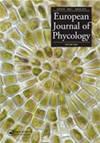细毛角犀(Bacillarophyta)物种复合体的形态和遗传多样性研究
IF 1.7
4区 生物学
Q2 MARINE & FRESHWATER BIOLOGY
引用次数: 3
摘要
摘要在海洋浮游硅藻中,Chaetoceros属是物种最丰富的属之一,许多Chaetocero物种被认为是重要的初级生产者。然而,人们对该属少数小型独居物种的生态和分布知之甚少,包括细毛角犀。这篇文章描述了一种微小的Chaetoceros菌株,被鉴定为C.tenuissimus(命名为CT16ED),它是在地中海西部科西嘉岛的一个沿海泻湖中分离出来的。通过光学显微镜、扫描和透射电子显微镜对该菌株进行了表征,特别关注刚毛的精细结构和结构及其在培养中的行为。通过对从18S rDNA到28S rDNA的D3区的核核糖体DNA(rDNA)片段和编码大RuBisCO亚基的质体rbcL基因进行测序,将CT16ED菌株与我们从物种类型地区(北海奥斯坦德港)分离的其他菌株进行了比较。根据文献和现有的序列数据,所分析的菌株与细柄木相似,但系统发育分析表明细柄木物种复合体包含多个分支,因此讨论了细柄木目前的分类地位。与被认为是细柄灰蝶同义词的菌株(包括Chaetoceros simplex var.cacitrans、Chaetocero calcitrans和Chaetocerus calcitrans.f.pumilus)的可用rDNA和rbcL测序数据的比较表明,这些分类群在灰蝶属内是异系的。本文章由计算机程序翻译,如有差异,请以英文原文为准。
Insight into the morphology and genetic diversity of the Chaetoceros tenuissimus (Bacillariophyta) species complex
ABSTRACT Among the marine planktonic diatoms, Chaetoceros is among the most species-rich genera, and many Chaetoceros species are considered important primary producers. However, little is known about the ecology and distribution of the few small solitary species within this genus, including Chaetoceros tenuissimus. This article describes a minute Chaetoceros strain, identified as C. tenuissimus (named CT16ED) that was isolated at a coastal lagoon in Corsica Island, Western Mediterranean. The strain was characterized by light microscopy and scanning and transmission electron microscopy, with a specific focus on the fine structure and construction of setae and its behaviour in culture. The CT16ED strain was compared with other strains we isolated from the species type locality (Ostend Harbour, North Sea) by sequencing a fragment of the nuclear ribosomal DNA (rDNA) spanning from the 18S rDNA to the D3 region of the 28S rDNA, and the plastid rbcL gene that codes the large RuBisCO subunit. Based on the literature and the available sequence data, the analysed strains were similar to C. tenuissimus but the phylogenetic analysis indicated a C. tenuissimus species complex that contained several clades, therefore the current taxonomic status of C. tenuissimus is discussed. The comparison with the available rDNA and rbcL sequencing data of strains assigned to species considered as synonyms of C. tenuissimus, including Chaetoceros simplex var. calcitrans, Chaetoceros calcitrans and Chaetoceros calcitrans f. pumilus, suggested that these taxa are paraphyletic within the genus Chaetoceros.
求助全文
通过发布文献求助,成功后即可免费获取论文全文。
去求助
来源期刊

European Journal of Phycology
生物-海洋与淡水生物学
CiteScore
4.80
自引率
4.20%
发文量
37
审稿时长
>12 weeks
期刊介绍:
The European Journal of Phycology is an important focus for the activities of algal researchers all over the world. The Editors-in-Chief are assisted by an international team of Associate Editors who are experts in the following fields: macroalgal ecology, microalgal ecology, physiology and biochemistry, cell biology, molecular biology, macroalgal and microalgal systematics, applied phycology and biotechnology. The European Journal of Phycology publishes papers on all aspects of algae, including cyanobacteria. Articles may be in the form of primary research papers and reviews of topical subjects.
The journal publishes high quality research and is well cited, with a consistently good Impact Factor.
 求助内容:
求助内容: 应助结果提醒方式:
应助结果提醒方式:


